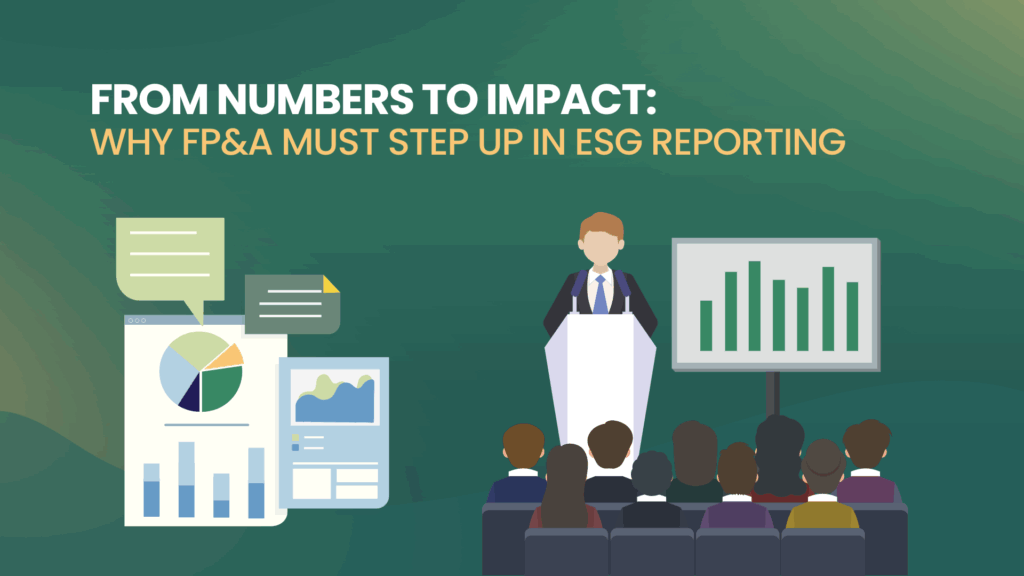From Numbers to Impact: Why FP&A Must Step Up in ESG Reporting

As part of this quarter’s tech theme at GrowCFO, the spotlight is on the evolving challenges and opportunities in FP&A. One theme becoming increasingly urgent is ESG reporting — and it’s a topic that will feature prominently in the upcoming FP&A Tech Innovation report and in tomorrow’s webinar led by GrowCFO’s FP&A Lead, Catherine Marks.
As ESG reporting moves from the sidelines to the spotlight, finance leaders face a new imperative: ensuring that environmental, social, and governance (ESG) performance is measured with the same rigor as financial results.
Historically, ESG reporting has been owned by sustainability or CSR teams — often focused on storytelling rather than structured data. But regulatory shifts like the CSRD in Europe and the SEC’s proposed climate disclosures in the U.S. are demanding financial-grade reporting. Stakeholders — from investors to employees — now expect not only transparency and accountability, but action.
The Missing Link in ESG Reporting
Finance teams are experts in precision — forecasting revenues, budgeting costs, tracking KPIs, and driving strategic insight. ESG data, in contrast, often remains fragmented, inconsistently defined, and strategically underleveraged.
This misalignment presents a significant opportunity for FP&A.
Why FP&A Should Lead the ESG Charge
FP&A professionals are uniquely equipped to transform ESG reporting from a compliance burden into a strategic advantage:
- Forecasting the future: From the cost of reducing Scope 3 emissions to assessing climate risk on long-term plans, FP&A can use scenario modeling to bring clarity.
- Measuring what matters: Embedding ESG KPIs into planning cycles ensures sustainability is integrated—not treated as an add-on.
- Quantifying impact: Finance can articulate the ROI of green investments, efficiency programs, and social initiatives in business terms.
- Ensuring data integrity: With proven controls for financial reporting, FP&A can apply the same standards to ESG disclosures.
Getting Started: Practical Moves for Finance Teams
For FP&A teams looking to step into ESG leadership, here are four starting points:
- Partner across the business – Collaborate with ESG, HR, operations, and compliance to identify data sources and close gaps.
- Integrate ESG into planning – Build environmental and social drivers into existing forecast models.
- Develop connected dashboards – Visualize ESG metrics alongside financial KPIs to drive insight.
- Upskill the team – While finance doesn’t need climate scientists, understanding material ESG issues is essential.
Technology Is Catching Up
New solutions are emerging to support this integration. Platforms like Workiva, OneStream, and Planful are expanding into ESG. AI is also playing a role in extracting insight from unstructured data, such as supplier reports or DEI surveys.
But tech alone isn’t the answer — FP&A must lead the change.
A Culture Shift Toward Value Creation
ESG is more than a reporting requirement; it’s a lens through which long-term value can be understood and shaped. Finance teams that embrace this perspective position themselves as strategic leaders of sustainable growth.
Because the future of finance isn’t just about how much is made — it’s about how it’s made.
Is your FP&A team engaging with ESG reporting? GrowCFO invites finance leaders to share their challenges, successes, and lessons learned as this transformation unfolds.
Don’t forget to join the conversation in tomorrow’s webinar: The Future of FP&A — Supporting the Chief Value Officer Transition.





Responses